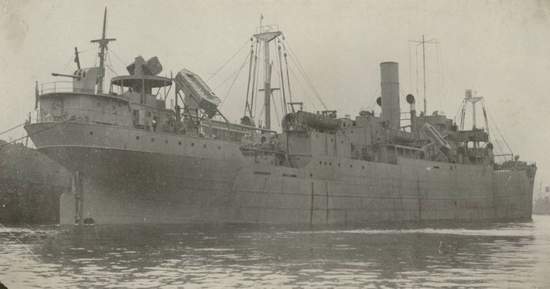Stakesby
British Steam merchant

Stakesby under her later name Empire Derwent. Photo Courtesy of Library of Contemporary History, Stuttgart
| Name | Stakesby | ||
| Type: | Steam merchant | ||
| Tonnage | 3,900 tons | ||
| Completed | 1930 - William Pickersgill & Sons Ltd, Sunderland | ||
| Owner | Headlam & Sons, Whitby | ||
| Homeport | Whitby | ||
| Date of attack | 25 Aug 1940 | Nationality: | |
| Fate | Damaged by U-124 (Georg-Wilhelm Schulz) | ||
| Position | 58° 52'N, 6° 34'W - Grid AM 3645 | ||
| Complement | 36 (0 dead and 36 survivors). | ||
| Convoy | HX-65A | ||
| Route | Newcastle, New Brunswick - Sydney, Cape Breton - Methil - Tyne | ||
| Cargo | Pit props | ||
| History | Completed in June 1930 Post-war: In 1946, the Empire Derwent was sold to Cereal Shipping & Trading Co (J.D. McLaren & Co), London and renamed Swan Point. On 31 Jul 1949, she went ashore near Chittagong and was declared a total loss. | ||
| Notes on event | Between 23.50 and 23.56 hours on 25 Aug 1940, U-124 fired four single torpedoes at four ships in convoy HX-65A 23 miles north of Butt of Lewis, Hebrides and claimed the sinking of all four. However, only three ships were hit: Harpalyce and Fircrest were sunk and the Stakesby was badly damaged. The Stakesby as leading ship of the most starboard column was the ship struck first, one torpedo hitting on the starboard side in #1 hold. The cargo kept the vessel afloat and she continued for one hour until the nine officers and 27 crewmen (the ship was armed with one 12pdr and one 4in gun) were forced to abandon ship because a fire forward could not be brought under control. They lowered three lifeboats and were picked up by the Norwegian steam merchant Cetus from the same convoy at 02.30 hours on 26 August. The survivors, one of them injured, were landed at Stornoway later that day, from where the rescue tug HMS Thames was sent to salvage the burning vessel. Stakesby was beached at Glumaig Bay after the tow rope broke and sank in shallow water. In January 1942, she was raised, temporarily patched and left Stornoway in tow for Rothesay Bay on 9 June 1942, where the ship arrived three days later. Temporary repairs were carried out at the Clyde and permanent repairs at Sunderland. She was rebuilt by the Ministry of War Transport (MoWT) and reentered service in 1943 as Empire Derwent (4026 grt) managed by Neill & Pandelis, London. | ||
| On board | We have details of 1 people who were on board. | ||
If you can help us with any additional information on this vessel then please contact us.
